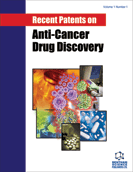Abstract
Resveratrol is a poly-phenol with many beneficial effects: not only as an antioxidant, anti-inflammatory, and antiatherogenic agent, as well as a platelet aggregation inhibitor, but also as an antiproliferative and proapoptotic factor in various types of cancers. There are reviews about the mechanisms responsible for its effects in leukemia and lymphomas, emphasizing the chemosensitizing role of resveratrol, which allows overcoming the multidrug resistance of cancers. The action of resveratrol occurs preferentially on leukemic cells, and not on the normal ones. In addition, it is one of the few drugs that act on leukemic stem cells. If experimental results are promising, its application in humans encounters some difficulties. The paper presents the causes of its low bioavailability, as well as recent patents that allow improvement of its bioavailability, development of new extraction procedures, obtaining new formulae, and associating resveratrol with other drugs in order to increase its effects. These patents allow optimizing its effects in order to obtain an adjuvant agent for treatment of oncohematological disorders.
Keywords: Antioxidant, apoptosis, leukemia, lymphoma, minimal residual disease, multidrug resistance, proliferation, resveratrol.
Recent Patents on Anti-Cancer Drug Discovery
Title:Could Resveratrol be a Useful Drug for the Treatment of Malignant Hemopathies?
Volume: 9 Issue: 3
Author(s): Romeo G. Mihaila
Affiliation:
Keywords: Antioxidant, apoptosis, leukemia, lymphoma, minimal residual disease, multidrug resistance, proliferation, resveratrol.
Abstract: Resveratrol is a poly-phenol with many beneficial effects: not only as an antioxidant, anti-inflammatory, and antiatherogenic agent, as well as a platelet aggregation inhibitor, but also as an antiproliferative and proapoptotic factor in various types of cancers. There are reviews about the mechanisms responsible for its effects in leukemia and lymphomas, emphasizing the chemosensitizing role of resveratrol, which allows overcoming the multidrug resistance of cancers. The action of resveratrol occurs preferentially on leukemic cells, and not on the normal ones. In addition, it is one of the few drugs that act on leukemic stem cells. If experimental results are promising, its application in humans encounters some difficulties. The paper presents the causes of its low bioavailability, as well as recent patents that allow improvement of its bioavailability, development of new extraction procedures, obtaining new formulae, and associating resveratrol with other drugs in order to increase its effects. These patents allow optimizing its effects in order to obtain an adjuvant agent for treatment of oncohematological disorders.
Export Options
About this article
Cite this article as:
Mihaila G. Romeo, Could Resveratrol be a Useful Drug for the Treatment of Malignant Hemopathies?, Recent Patents on Anti-Cancer Drug Discovery 2014; 9 (3) . https://dx.doi.org/10.2174/1574892809666140327161242
| DOI https://dx.doi.org/10.2174/1574892809666140327161242 |
Print ISSN 1574-8928 |
| Publisher Name Bentham Science Publisher |
Online ISSN 2212-3970 |
 37
37
- Author Guidelines
- Bentham Author Support Services (BASS)
- Graphical Abstracts
- Fabricating and Stating False Information
- Research Misconduct
- Post Publication Discussions and Corrections
- Publishing Ethics and Rectitude
- Increase Visibility of Your Article
- Archiving Policies
- Peer Review Workflow
- Order Your Article Before Print
- Promote Your Article
- Manuscript Transfer Facility
- Editorial Policies
- Allegations from Whistleblowers
Related Articles
-
Susceptibility of Helicobacter pylori to Natural Products: Can Past Research Direct Future Drug Development?
Current Bioactive Compounds Skeletal Survey in Multiple Myeloma: Role of Imaging
Current Medical Imaging Sphingolipids as Emerging Drug Targets: Therapeutic Applications of Ceramide Analogs
Drug Design Reviews - Online (Discontinued) Ewing’s Sarcoma Cancer Stem Cell Targeted Therapy
Current Stem Cell Research & Therapy Optimizing Outcomes Following Allogeneic Hematopoietic Progenitor Cell Transplantation in AML: The Role of Hypomethylating Agents
Current Cancer Drug Targets Flavopiridol, the First Cyclin-Dependent Kinase Inhibitor: Recent Advances in Combination Chemotherapy
Mini-Reviews in Medicinal Chemistry Recent Patents Reveal Microtubules as Persistent Promising Target for Novel Drug Development for Cancers
Recent Patents on Anti-Infective Drug Discovery Anti-Metastatics: An Overview of Drug Candidates in Current Pipelines
Current Pharmaceutical Design Immunosuppressive Treatments in Acute Myocardial Infarction and Stroke
Current Pharmaceutical Biotechnology Role of Infrared Spectroscopy and Imaging in Cancer Diagnosis
Current Medicinal Chemistry Recent Patents on Heat Shock Proteins Targeting Antibodies
Recent Patents on Anti-Cancer Drug Discovery Omalizumab for Asthma: Indications, Off-Label Uses and Future Directions
Recent Patents on Inflammation & Allergy Drug Discovery Tubulin Maytansine Site Binding Ligands and their Applications as MTAs and ADCs for Cancer Therapy
Current Medicinal Chemistry Challenges in the Management of Paediatric Febrile Neutropenia
Current Pediatric Reviews Adenosine Deaminase in the Modulation of Immune System and its Potential as a Novel Target for Treatment of Inflammatory Disorders
Current Drug Targets Chrysin Induces Apoptosis in Peripheral Blood Lymphocytes Isolated from Human Chronic Lymphocytic Leukemia
Anti-Cancer Agents in Medicinal Chemistry Landmark Studies of Targeted Therapies for Advanced Non-Small Cell Lung Cancer: A Guide for Pulmonologists
Current Respiratory Medicine Reviews Protein Z and Ischemic Stroke
Vascular Disease Prevention (Discontinued) A Review on PARP1 Inhibitors: Pharmacophore Modeling, Virtual and Biological Screening Studies to Identify Novel PARP1 Inhibitors
Current Topics in Medicinal Chemistry Recent Advances in Positron Emission Tomography (PET) Imaging of Biomolecules: From Chemical Labeling to Cancer Diagnostics
Mini-Reviews in Organic Chemistry


























